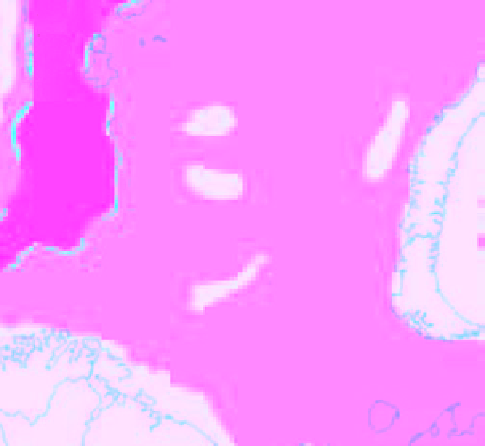Geoscience Reference
In-Depth Information
Carboniferous, eventually initiating the Uralide
Orogeny (Smelror
et al
. 2009), which successively
propagated northwards. The final folding took
place to the east of the Timan Pechora Basin
(Fig. 2A) and in Novaya Zemlya during Permian
to Early Jurassic times (O'Leary
et al
., 2004;
Ritzman & Faleide, 2009).
The current regional structure of the Barents Sea
east of Novaya Zemlya is dominated by the North
and South Barents basins (Fig. 2A), which where
the main depocentres during Palaeozoic and
Mesozoic times (Johansen
et al
., 1993; Henriksen
et al
., 2011). These basins pass westwards into
broader structural platforms and highs, separated
by a set of predominantly SW to NE oriented
basins. In the Norwegian sector, the Hammerfest
(detailed in Fig. 2B) and Nordkapp basins are
bounded to the south by the Finnmark Platform
and to the north by the Bjarmeland Platform and
the Loppa High.
Sedimentation in the Barents Sea area prior to
the Uralide Orogen culminated in the establish-
ment of widespread Late Carboniferous to Permian
marine carbonate platforms across the entire shelf,
extending eastwards and southwards into the
Tethyan domain (Ziegler, 1988; Smelror
et al
.,
2009). The Uralide uplift to the east, coupled with
persisting crustal extension to the west eventually
reversed the sedimentation patterns across the
Barents shelf (Smelror
et al
. 2009; Henriksen
et al
.
2011). Thus, the marine connection to the south-
east was closed by end-Permian time and vast
amounts of clastic material were transported from
the Uralides towards the north and north-west
across the entire Barents shelf, as recorded from
seismic data revealing the progradation pattern of
Early to Late Triassic shelf edges (Riis
et al
. 2008;
Glørstad-Clark
et al
. 2010). Basins and platforms
in the south-west Barents Sea area experienced
significant subsidence during the Triassic, with
accumulation of more than 3 km of clastic sedi-
ment (e.g. Riis
et al
. 2008).
Fig. 3 shows a schematic palaeogeographic
model for the Late Triassic in the Barents Sea area.
A widespread coastal plain/delta plain environ-
ment stretched westwards from Novaya Zemlya
and Timan Pechora towards a marine seaway
between the western Barents shelf and the
Greenland landmass. The most significant clastic
hinterlands were located to the east, within the
Uralides, with a more limited flux from the
Fennoscandian hinterland to the south (Riis
et al
.
2008). Triassic sandstones, derived from the
Svalbard
0
km
500
Loppa
High
Bjarmeland
Platform
South
Barents
Basin
Norway
Russia
Highlands/denudation areas
Coastal plain/delta plain
Sandy shoreline
Shallow marine shelf
Fig. 3.
Late Triassic palaeogeographic setting in the Barents
Sea (modified from Henriksen
et al
. 2011). The south-west
Barents Sea may have been located at a palaeo-latitude of
about 50° to 55°N during the Late Triassic (Golonka, 2007;
Worsley, 2008).
Uralide hinterland to the south-east, are typically
characterised by abundant plagioclase feldspars,
which can be recognised, e.g. across the Bjarmeland
Platform (Mørk, 1999). Jurassic sandstones are, in
contrast, more quartz-rich and generally depleted
in plagioclases (Bergan & Knarud, 1993).
Sediment supply from westerly sources
(Greenland) has been documented from Triassic
strata in western Svalbard (e.g. Steel & Worsley,
1984; Riis
et al
., 2008). Also, seismic data from
the western Barents Sea margin may indicate that
sediment from a westerly hinterland entered the
western margin of the Loppa High (Glørstad-Clark
et al
., 2010), particularly during Ladinian to
Carnian times. Accordingly, some evidence exists
that the marine seaway in the Atlantic rift was
closed during phases of maximum shoreline
regression.
The Early Jurassic palaeogeographic setting in
the Barents Sea area seems to follow similar distri-
bution patterns as inferred for the Late Triassic,
with a marine seaway to the west and sediment
supply from the south and east across the Barents
shelf (Smelror
et al
., 2009; Henriksen
et al
., 2011).
However, marine incursions into the Russian





Search WWH ::

Custom Search